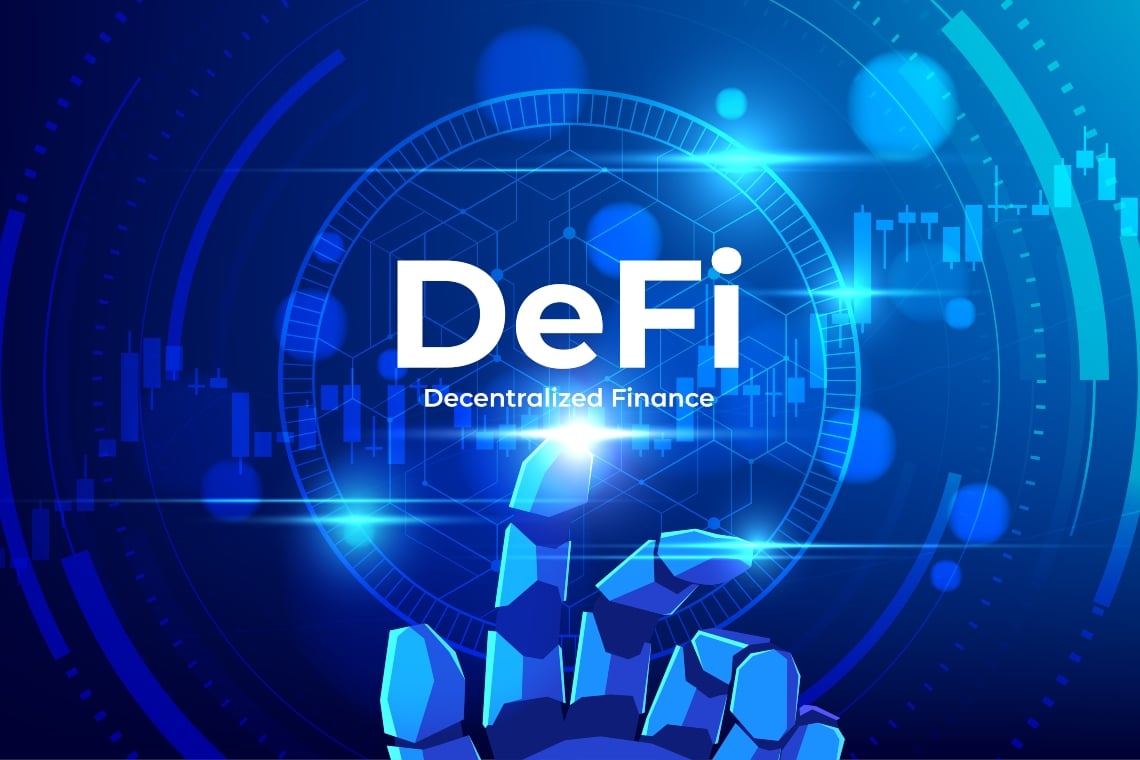
What is DeFi (decentralized finance)?
Decentralized Finance (DeFi) refers to a new financial system that operates on a decentralized, permissionless blockchain network. DeFi applications aim to provide financial services that are accessible to anyone with an internet connection and without the need for traditional intermediaries such as banks or financial institutions. Instead, DeFi relies on smart contracts and decentralized applications (dApps) that operate autonomously on blockchain networks such as Ethereum.
DeFi applications provide a wide range of financial services, including lending and borrowing, trading, staking, yield farming, and insurance. Users can interact with DeFi applications using digital assets such as cryptocurrencies, stablecoins, and other blockchain-based tokens.
One of the key features of DeFi is its open and permissionless nature, which means that anyone can participate in the ecosystem and contribute to its development. DeFi also provides greater transparency, as all transactions are recorded on a public blockchain and can be audited by anyone. However, DeFi is still a relatively new and experimental technology, and there are still risks and challenges associated with its use, such as smart contract bugs and market volatility.
DeFi vs. CeFi (Centralized Finance)

| Aspect | DeFi | CeFi |
|---|---|---|
| Control | Decentralized | Centralized |
| Intermediaries | Eliminates intermediaries | Relies on intermediaries |
| Access | Open access to anyone with an internet connection | Restricted access based on KYC and jurisdiction |
| Asset custody | User-controlled wallets | Custody with centralized entities |
| Transparency | Transparent and auditable transactions | Limited transparency |
| Security | Self-custodial wallets with private keys | Custodial wallets with security measures |
| Liquidity | Pools of liquidity from individuals | Pools of liquidity from institutional investors |
| Innovation | Flexible and fast | Limited by centralized systems |
| Regulation | Self-governing, largely unregulated | Regulated and monitored by authorities |
| Counterparty risk | Minimal | Exists due to centralized counterparties |
It’s important to note that while DeFi and CeFi have some distinct differences, they also have some similarities. For example, both systems involve the exchange of financial assets and are subject to market risks and volatility. Ultimately, the choice between DeFi and CeFi depends on individual preferences and needs.
Traditional Finance vs Defi
| Aspect | Traditional Finance | DeFi |
|---|---|---|
| Control | Centralized | Decentralized |
| Intermediaries | Relies on intermediaries | Eliminates intermediaries |
| Access | Restricted access based on KYC and jurisdiction | Open access to anyone with an internet connection |
| Asset custody | Custody with centralized entities | User-controlled wallets |
| Transparency | Limited transparency | Transparent and auditable transactions |
| Security | Custodial wallets with security measures | Self-custodial wallets with private keys |
| Liquidity | Pools of liquidity from institutional investors | Pools of liquidity from individuals |
| Innovation | Limited by regulatory constraints and legacy systems | Flexible and fast |
| Regulation | Regulated and monitored by authorities | Self-governing, largely unregulated |
| Counterparty risk | Exists due to centralized counterparties | Minimal |
Why is decentralized finance(DeFi) important?
- Financial inclusion: DeFi provides an opportunity for anyone with an internet connection to access financial services, even if they are excluded from the traditional financial system. This can help to promote financial inclusion and reduce poverty.
- Transparency: Transactions on a blockchain network are transparent and can be audited by anyone. This provides greater transparency in financial transactions and helps to prevent fraud and corruption.
- Accessibility: DeFi is accessible to anyone with an internet connection, which means that users can access financial services from anywhere in the world, without having to go through intermediaries such as banks and financial institutions.
- Security: Decentralization provides some security benefits, as transactions are recorded on a public blockchain and cannot be altered or deleted. Additionally, smart contracts can be used to automate financial transactions and reduce the risk of human error.
- Innovation: DeFi provides an opportunity for developers to experiment with new financial products and services, which can lead to greater innovation in the financial sector.
- Lower costs: DeFi transactions are generally cheaper than traditional financial transactions, as they do not involve intermediaries and can be processed more quickly.
How does DeFi work?
Decentralized finance (DeFi) works by using blockchain technology to create a decentralized financial system that is open, transparent, and accessible to anyone with an internet connection. Here’s a basic overview of how DeFi works:
- Blockchain technology: DeFi is built on top of blockchain technology, which is a distributed ledger that records all transactions in a secure and transparent manner.
- Decentralized applications (dApps): DeFi uses decentralized applications (dApps) to provide financial services such as lending, borrowing, trading, and more. These dApps are built on top of a blockchain network, such as Ethereum, and are powered by smart contracts.
- Smart contracts: Smart contracts are self-executing contracts that are stored on the blockchain network. They automatically execute when certain conditions are met, such as when a borrower repays a loan.
- Cryptocurrencies: DeFi transactions are conducted using cryptocurrencies such as Ether (ETH) or Bitcoin (BTC). These cryptocurrencies are used to pay transaction fees and can also be used as collateral for loans.
- Liquidity pools: DeFi platforms use liquidity pools to provide liquidity for trading and other financial services. Liquidity providers can earn rewards by contributing funds to the pool, which can be used to facilitate trades.
- Interoperability: DeFi platforms can be interconnected, which allows for the seamless transfer of assets between different platforms. This is made possible by the use of standards such as ERC-20, which ensures that tokens are compatible across different platforms.
What makes up decentralized finance(DeFi)?
Decentralized finance (DeFi) is made up of decentralized applications (dApps), smart contracts, cryptocurrencies, decentralized exchanges (DEXs), stablecoins, and other components that together provide financial services such as lending, borrowing, trading, and more in a decentralized and open manner.
Decentralized exchanges (DEXs)
Decentralized exchanges, or DEXs, are a type of cryptocurrency exchange that operates on a decentralized blockchain network, rather than a centralized server. In other words, transactions on a DEX occur directly between users, rather than being processed and recorded by a third-party exchange.
This decentralized approach offers a number of advantages over traditional centralized exchanges. For example, DEXs are generally more resistant to hacking and other security threats, since there is no central point of failure. Additionally, they are often faster and more efficient, since transactions can be processed instantly, rather than having to wait for confirmation from a central authority.
However, DEXs can also have some drawbacks. For example, they may not offer as much liquidity as centralized exchanges, meaning that users may have to wait longer to find a match for their desired trades. Additionally, some DEXs may be more difficult to use for beginners, as they require users to have a basic understanding of how blockchain technology and cryptocurrency wallets work.
Overall, DEXs are a promising new development in the world of cryptocurrency, offering a more secure and decentralized alternative to traditional centralized exchanges. However, as with any new technology, there are still some challenges to overcome, and it remains to be seen how widely adopted DEXs will become in the future.
Aggregators and wallets
Aggregators and wallets are two important tools for managing cryptocurrency.
Aggregators are platforms that allow users to compare prices and exchange rates across multiple cryptocurrency exchanges. They help users find the best price for a particular trade and can save users time and money by consolidating information from multiple sources. Aggregators typically charge a small fee for their services.
Wallets, on the other hand, are software programs or hardware devices that allow users to store, send, and receive cryptocurrency. They are essential for anyone looking to buy or trade cryptocurrencies, as they provide a secure place to store your digital assets. Wallets come in many forms, from desktop and mobile apps to physical hardware devices that are designed to keep your cryptocurrency offline and away from potential security threats.
Both aggregators and wallets are important tools for managing cryptocurrency. Aggregators help users find the best prices and save money on trades, while wallets provide a secure way to store and manage digital assets. Together, these tools help make cryptocurrency more accessible and easier to use for people all over the world.
Decentralized marketplaces
Decentralized marketplaces are online platforms built on blockchain technology that enable direct transactions between buyers and sellers without the need for intermediaries. These marketplaces offer greater security and transparency, as all transactions are recorded on the blockchain, providing an immutable record of all activity. Decentralized marketplaces are typically powered by cryptocurrency tokens and can reduce transaction costs and increase efficiency by eliminating intermediaries. Overall, decentralized marketplaces have the potential to revolutionize e-commerce by providing a more secure and transparent way of buying and selling goods and services online.
Oracles/prediction markets
Oracles and prediction markets are two related concepts in the blockchain and cryptocurrency space.
Oracles are third-party services that provide data and information to blockchain networks. They allow smart contracts to access information from outside the blockchain, enabling them to execute more complex functions. Oracles are important because they allow blockchain networks to interact with the real world, enabling a wide range of new applications.
Prediction markets are decentralized marketplaces that allow users to bet on the outcome of future events. They enable users to speculate on the likelihood of certain events occurring, such as the outcome of an election or the price of a commodity. Prediction markets rely on the wisdom of the crowd to make predictions, as users bet on the outcomes they think are most likely to occur. These markets can provide valuable insights into the likelihood of future events and are often used in industries such as finance and insurance.
Together, oracles and prediction markets enable a wide range of new applications in the blockchain and cryptocurrency space. Oracles allow blockchain networks to interact with the real world, while prediction markets provide a decentralized way to make predictions about future events. By enabling these new applications, oracles and prediction markets are helping to drive the growth and adoption of blockchain technology.
DeFi use cases
Decentralized finance (DeFi) offers a range of use cases, including:
- Decentralized Exchanges (DEXs): DEXs allow users to trade cryptocurrencies in a decentralized manner, without the need for intermediaries. This provides greater security, transparency, and control for users, and can also reduce transaction costs.
- Lending and Borrowing: DeFi lending and borrowing platforms allow users to borrow and lend cryptocurrencies without the need for traditional financial institutions. This offers greater accessibility and flexibility for borrowers and lenders, and can also provide higher yields compared to traditional financial institutions.
- Stablecoins: Stablecoins are cryptocurrencies that are designed to maintain a stable value relative to a particular asset or currency. They are often used as a means of exchange and can help reduce volatility in the cryptocurrency market.
- Yield Farming: Yield farming is a DeFi practice that involves using various strategies to earn a yield on cryptocurrency holdings. This can include staking, liquidity provision, and other activities that help to generate returns on cryptocurrency assets.
- Decentralized Insurance: DeFi insurance platforms allow users to purchase insurance coverage for their cryptocurrency holdings. These platforms use smart contracts to automate the insurance process and provide greater transparency and security for users.
- Decentralized Identity: DeFi can also be used for identity verification and management, enabling users to control and manage their digital identity without the need for centralized authorities.
- Decentralized Prediction Markets: DeFi prediction markets enable users to speculate on the outcome of future events, providing a decentralized way to make predictions and gather information about future trends.
DeFi-native activities
DeFi-native activities are those activities that are specific to the decentralized finance (DeFi) ecosystem and cannot be easily replicated or performed in the traditional financial system. These activities include:
- Liquidity Provision: DeFi liquidity provision involves providing liquidity to decentralized exchanges (DEXs) by depositing cryptocurrencies in liquidity pools. Liquidity providers earn a share of the transaction fees generated by the DEXs and can also earn additional rewards in the form of tokens.
- Yield Farming: Yield farming is a DeFi activity that involves using various strategies to earn a yield on cryptocurrency holdings. This can include staking, liquidity provision, and other activities that help to generate returns on cryptocurrency assets.
- Governance: DeFi platforms often have decentralized governance systems that allow token holders to vote on important decisions such as platform upgrades and changes to protocols.
- Flash Loans: Flash loans are a unique DeFi activity that enables users to borrow cryptocurrency without any collateral, as long as the loan is repaid within the same transaction. Flash loans are used for a variety of purposes, including arbitrage, market making, and liquidations.
- Token Swaps: DeFi platforms allow users to swap one cryptocurrency for another without the need for intermediaries. This provides greater accessibility and flexibility for users, and can also reduce transaction costs.
DeFi risks?
- Smart Contract Risks: Smart contracts are self-executing contracts with the terms of the agreement between buyer and seller being directly written into lines of code. Any vulnerabilities in smart contracts can result in losses of funds, which could be exploited by attackers. This is particularly true for new and untested protocols.
- Price Volatility: The price of cryptocurrencies can be extremely volatile, which can result in significant losses for DeFi users. The use of leverage and borrowing can further increase the risks associated with price volatility.
- Liquidity Risks: DeFi liquidity can be affected by market volatility, with low liquidity potentially leading to high slippage and price impact. This can result in losses for traders and liquidity providers.
- Regulatory Risks: The DeFi ecosystem is largely unregulated, which could result in the introduction of new regulations that may restrict or limit DeFi activities.
- Hacking and Security Risks: DeFi platforms are susceptible to hacking and security breaches, which can result in the loss of funds. While security measures have been put in place, they are not infallible.
- Centralization Risks: Despite being decentralized, some DeFi platforms may have centralized points of failure, such as the use of centralized oracles, which can create vulnerabilities and risks for users.
How do you make money with DeFi?
There are several ways to make money with DeFi, but it’s important to note that like any investment, there are also risks involved. Here are some ways to potentially earn profits in the DeFi ecosystem:
- Yield Farming: Yield farming is a DeFi activity that involves using various strategies to earn a yield on cryptocurrency holdings. This can include staking, liquidity provision, and other activities that help to generate returns on cryptocurrency assets.
- Liquidity Provision: DeFi liquidity provision involves providing liquidity to decentralized exchanges (DEXs) by depositing cryptocurrencies in liquidity pools. Liquidity providers earn a share of the transaction fees generated by the DEXs and can also earn additional rewards in the form of tokens.
- Token Trading: DeFi platforms allow users to trade tokens without intermediaries, which can result in lower transaction fees and potentially higher profits from trading.
- Borrowing and Lending: DeFi lending and borrowing platforms allow users to borrow and lend cryptocurrencies without the need for traditional financial institutions. This offers greater accessibility and flexibility for borrowers and lenders, and can also provide higher yields compared to traditional financial institutions.
- Staking: Staking involves holding a particular cryptocurrency in a wallet for a certain period of time to help secure the network and validate transactions. In exchange, stakers can earn rewards in the form of additional cryptocurrency.
Is it safe to invest in DeFi?
DeFi investments come with risks like any other investment. While DeFi platforms are generally considered safe, it’s important to conduct thorough research, use reputable platforms, and understand the risks associated with price volatility, smart contract vulnerabilities, and security breaches.










